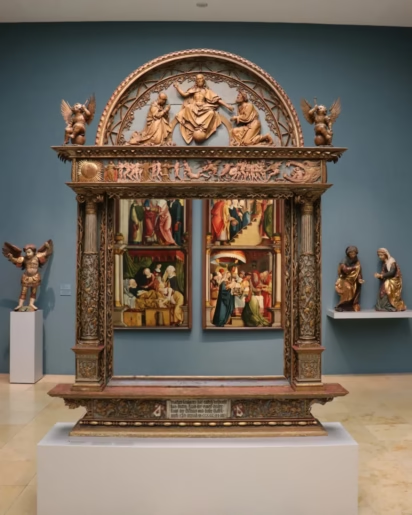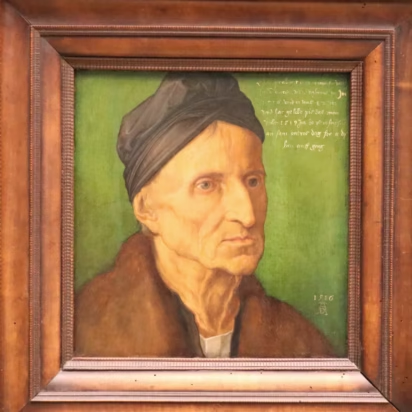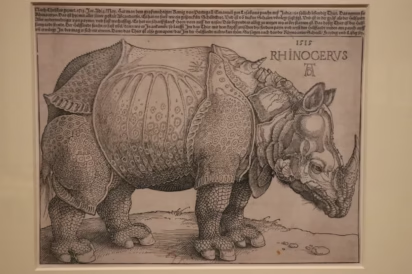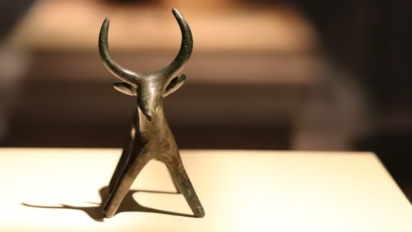The Germanisches Nationalmuseum in Nuremberg (Nürnberg) is the largest cultural history museum in Germany and covers fine art and culture of the broader German-speaking world from prehistory to the present.

The Germanisches Nationalmuseum in Nuremberg (Nürnberg) comprehensively covers the art and culture of the German-speaking world over the last 200,000 years. It is the largest cultural history museum in Germany and as an important research center, has an academic approach that suits the high quality of the around 25,000 items on permanent display. Highlights include fine arts from the Middle Ages, Renaissance, and Baroque but applied arts and crafts from the middle ages to the 19th century are also covered in detail. The Nürnberg City Card is accepted while admission is free on Wednesday evenings.
Germanisches Nationalmuseum in Nuremberg
The largest cultural history museum in Germany, the Germanisches Nationalmuseum is located in Nuremberg rather than a major city such as Berlin, Hamburg, or Munich. The reason is partly historical as the museum was founded in 1852, around two decades before Germany was united into a single political entity.
The museum always uses the German name only. “Germanisches” means Germanic and in the context of the Germanisches Nationalmuseum should be interpreted to include anything culturally and artistically related to the German-speaking world. It covers a very wide spectrum and the museum’s over 1.3 million items date from around 200,000 BC to the present.
The Germanisches Nationalmuseum is an important research and educational institution. Its scientific approach is extended to the permanent exhibitions which are formally displayed, academically described, and not dumbed down in any way. It is a serious museum with seriously impressive art and artifacts on display.
The choice of Nuremberg for the Germanisches Nationalmuseum in the mid-19th century was a logical one. For centuries, Nuremberg was a free imperial city and one of the major political, art, and trade centers in Germany. Nuremberg was at the geographical center of the German-speaking world — a factor that contributed to the city being chosen for the first Nazi party rallies in the 1920s as well as for the Nuremberg trials in 1945.
Collections in the Germanisches Nationalmuseum
The collections of the Germanisches Nationalmuseum cover a very wide field and include anything remotely associated with art and culture in the wider German-speaking world.
The main permanent exhibitions in the Germanisches Nationalmuseum are:
Pre- and Early History — this exhibition on the ground floor of the museum spans a long period: 200,000 BC – 800 AD. (The Romans in Germany are better covered elsewhere, e.g. in Cologne, Mainz, and Trier.) Top items include the Golden ceremonial hat (1100-800 BC), a Hallstatt period cast bronze bull (700-500 BC), and the Ostrogothic eagle-shaped fibula (Adlerfibel) from around AD500.
Middle Ages — 8th to 15th-century sculptures, textiles, objects of treasury art, stained glass, and panel paintings. Highlights include the Imperial reliquary shrine (mid-15th century), treasure binding of the “Codex Aureus” (10th century), and the Carolingian Ardenne Cross.
Late Middle Ages — paintings, sculpture, and other mostly religious artworks produced in the 14th and 15th centuries. Top works include Tilman Riemenschneider’s St Elizabeth and Lamentation of Christ, paintings by Hans Holbein, and many unnamed masters.
Renaissance, Baroque, Enlightenment — a vast collection of paintings and sculptures, stained-glass windows, the decorative arts, furniture, musical instruments, medals, textiles, and jewelry that fills 33 rooms. This exhibition includes top works by amongst others Albrecht Dürer, Lucas Cranach, Veit Stoß, and Rembrandt but also houses the Behaim Globe and the Schlüsselfelder Ship.
19th-Century Art — a fine collection of mostly paintings and sculptures only collected after the Second World War. (Other museums in Germany probably have a better collection, e.g. Neue Pinakothek in Munich or the Alte Nationalgalerie in Berlin.)
20th Century Art — a large collection of paintings, sculptures, and design classics.
Scientific Instruments — this fine collection may be seen in the foyer en route to the Renaissance and Baroque exhibitions. Many instruments measure time while the 14 astrolabes are unmatched in the German-speaking world. The Behaim terrestrial globe is the oldest in the world and was admitted to UNESCO’s Memory of the World.
Crafts and Medicine — a vast collection of items from the early 16th to late 19th century when trade and medicine were not as far removed from fine arts.
Everyday Culture up to 1700 — a variety of furniture, fittings, utensils, and items from the higher strata of society (but not necessarily nobility) from the Late Middle Ages to the Early Modern Age.
Decorative Arts of the Baroque — room furnishings, decorations, tableware, drinking utensils with an emphasis on German faience art from the 17th and 18th centuries, and porcelain.
Clothing from 1700 — around 300 sets of clothing from 1700 to 1970 illustrating fashion trends and their social connections.
Musical Instruments — 500 instruments explain the development of European music from the 16th century to the present.
Weaponry, Hunting, Garden Culture — historical weaponry from the Middle Ages to the 18th century from miniature pistols to cannon barrels and knight’s tournament equipment. The collection includes the Handbüchse von Burg Tannenberg (before 1399) — the oldest dateable hand-held firearm in the world. The garden culture includes mostly sculptures from the Baroque era.
Toys — toys from the mid-16th to the 20th centuries. Highlights include large 17th-century dollhouses and paper theater. The exhibition is in a separate building and not to be confused with the municipal Toy Museum (Spielzeugmuseum) — both are very much see-and-don’t-touch collections!
The museum has further frequent temporary exhibitions — usually included in the regular admission price.
The Germanisches Nationalmuseum also has large numismatic, prints, and drawings collections, as well as extensive art and historical archives. These may only be seen on special requests.
Top Highlights to See in the Germanisches Nationalmuseum in Nuremberg
The highlight of the Germanisches Nationalmuseum in Nuremberg is the Behaim terrestrial globe (Behaim-Globus) in room 102, also known as the Behaim Erdappel (literally, “earth apple”). This globe was made in Nuremberg around 1492 by Martin Behaim and Georg Glockendon the Elder and is the oldest surviving depiction of the world in global form. The Americas (and Australia) were still unknown in Europe and the Behaim globe used the world’s circumference according to the Greek Ptolemy’s estimate of 29,000 km rather than the real 40,000 km at the equator. In 2023, Erdapfel was admitted to UNESCO’s Memory of the World.
Two highlights from the early history sections are the Golden ceremonial hat from Ezelsdorf (1100-800 BC), in room 9, and the Ostrogothic eagle-shaped fibula (Adlerfibel) from around AD500 in room 7.
Picking a fine art highlight is more difficult. Albrecht’s Dürer’s painting of Charlemagne in his Coronation Robes is world famous. However, this is not his best work by far — even in this museum his paintings of Michael Wolgemut and of his mother are considered to be of more art historical importance. A copy of Dürer’s hugely influential Rhinocerus (1515) print is often on display — it determined to a large extent Europe’s idea of what a rhino looked like for over 250 years. The museum has fine examples of Lucas Cranach’s Martin Luther and Venus and Cupid the Honey Thief but similar works may be seen elsewhere too. Top sculptures are by Veit Stoß (Archangel Raphael and Tobias, Antler Chandelier in the Shape of a Dragon) and Tilman Riemenschneider (Lamentation of Christ, St Elizabeth).
Visit the Germanisches National Museum in Nuremberg (Nürnberg)
The Germanisches Nationalmuseum is massive. Although only around 25,000 of the more than 1.3 million items in the collection are on permanent display, no one could manage to see the whole museum in a day — covering more than two of the main sections in any detail in a single day is already a big ask.
A good way to prepare for a visit, is to study (and download) the museum map — the same page gives an indication of which halls are closed for refurbishing. The museum is spread over several buildings and not all are connected at all levels
If visiting without a specific interest, the following might be the best options for a short visit (but all the collections have very high quality and exquisite artifacts on display):
- Renaissance Baroque Enlightenment (Renaissance Barock Aufklärung on the first floor) — fine art with top works by amongst others Albrecht Dürer, Lucas Cranach, Veit Stoß, as well as the Behaim Globe.
- Late Middle Ages (Spätmittelalter on the ground floor) — mostly closed until 2024 (but worth the wait).
- Middle Ages, Prehistory, and Protohistory (Mittelalter and Ur- und Frühgeschichte on the ground floor) — at least have a glance at the top highlights.
Although the museum has fine collections of 19th and 20th-century fine art, these are probably best left for further visits. The earlier works are more engaging and similar works are less easily seen elsewhere.
Germanisches Nationalmuseum in Nuremberg Visitors’ Information

Opening Hours of the Germanisches Nationalmuseum
The Germanisches Nationalmuseum in Nuremberg is open Tuesday to Sunday from 10:00 to 18:00 (closing at 20:30 on Wednesdays). Admission is free on Wednesdays after 17:30.
The museum is usually open on public holidays, including if on a Monday, but closed on December 24, 25, and 31, and on Fasching (Carnival).
Download the museum map before visiting — the page also gives an indication of which halls are closed. (The German site is more detailed.)
Tickets for the Germanisches Nationalmuseum
Admission to the Germanisches Nationalmuseum is €10 for adults and €6 for children 7 to 17 years and students. Families receive significant discounts if parents travel with children under 18.
The Nürnerg City Card is accepted. Small discounts are given if arriving with a local public transportation ticket (VGN).
Transportation to the Germanisches National Museum in Nuremberg
The Germanisches Nationalmuseum, Kartaeusergasse 1, 90402 Nürnberg, is in the southern part of the old town center of Nuremberg. The closest U-Bahn stations are Lorenzkirche (U1) and Opernhaus (U2) but from the old town or Hauptbahnhof (main station), walking is often faster. It is also only a few blocks from the DB German Railways Museum.
More on Traveling to Nürnberg:

More resources for planning travel to Nuremberg in Bavaria, Germany:
- Buy a Nürnberg City Card to save on sightseeing and transportation.
- Top Sights to See in Nuremberg:
- Visit the Nuremberg Trials Memorial (Courtroom 600)
- Reichsparteitagsgelände (Nazi Party Rally Grounds)
- Visit the Germanisches Nationalmuseum — the largest cultural history museum in Germany.
- Visit the Kaiserburg — Imperial Castle in Nuremberg
- Visit the Albrecht-Dürer-Haus Museum where the artist lived and worked for two decades.
- Visit the DB German Railways Museum
- Visit the Nuremberg Christmas Market (Nürnberger Christkindlesmarkt)
- Transportation to Nuremberg in Bavaria
- Traveling by Train to Nuremberg – German Railways Timetables to Nuremberg
- Book Flights on Lufthansa, KLM, or Air France.
- Cheap Flights to Nuremberg Airport (NUE)
- Transportation to Nuremberg Airport (NUE)
- Transportation from Munich Airport (MUC) to Nuremberg
- Nuremberg hotels are generally less pricey than those in Frankfurt or Munich.
- Adidas Factory Outlet Stores — half an hour north of Nuremberg but a very popular stop en route to Bamberg.
- Suntransfers give online quotations without requiring flight and personal details.









